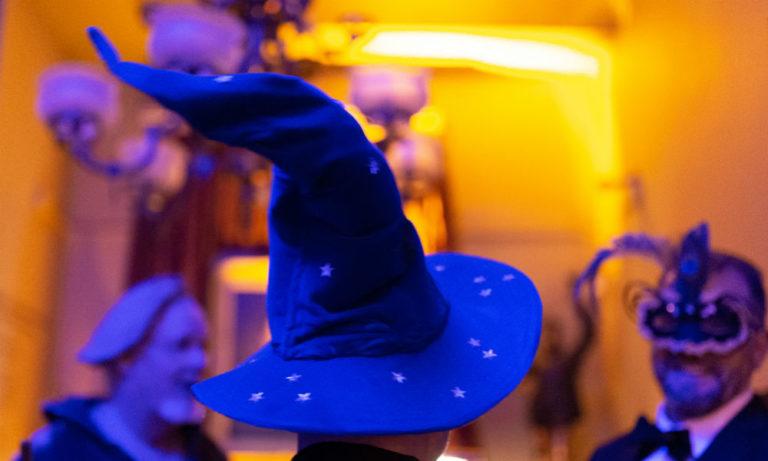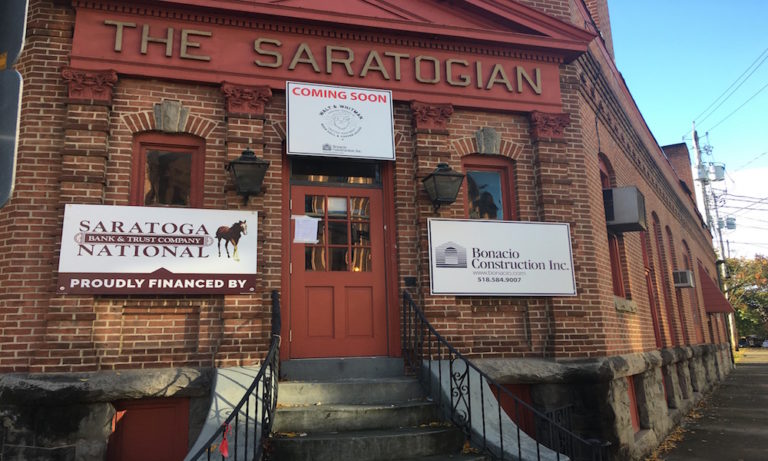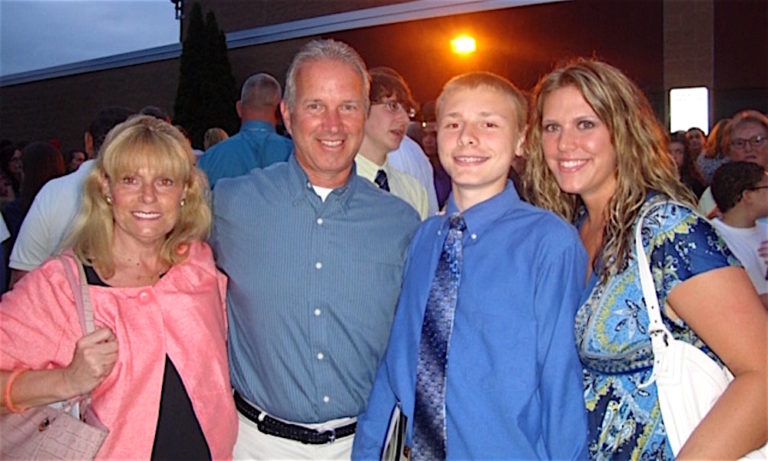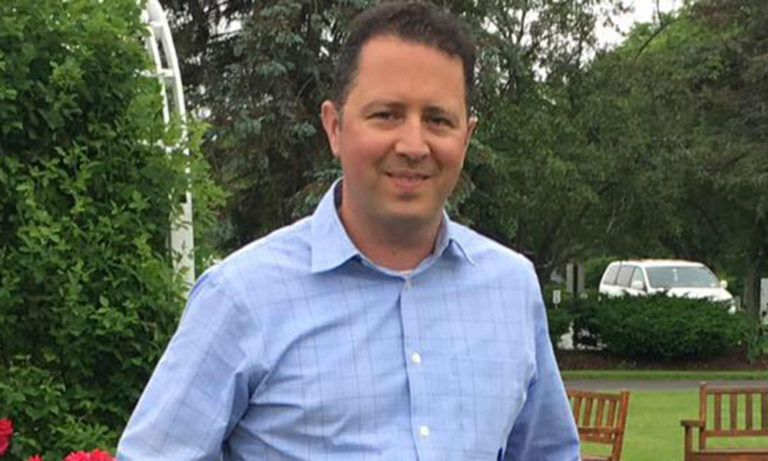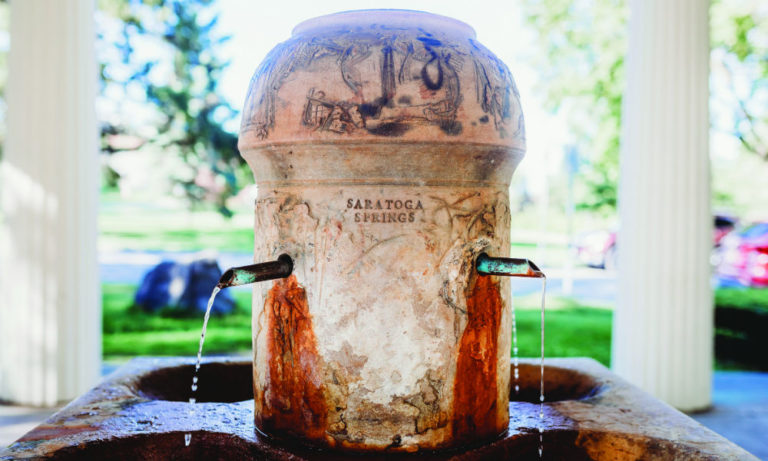Hocus Pocus! This past Thursday, October 3, Radial Arts (formerly known as SaratogaArtsFest) hosted its annual All Hallows’ Eve Masquerade Ball, an immersive, costume-filled theatrical event, which this year featured a spooky witchcraft theme. The Canfield Casino was transformed into a fantasy wonderland, an elegant sit-down dinner was catered by Lily and the Rose and an open bar offered signature cocktails specially brewed for the event. Guests were entertained by pop-up performances throughout the night and all proceeds raised during the live auction will support Radial Arts’ 2019-2020 free art events. Radial Arts helps introduce new audiences to the Capital Region’s artistic and cultural organizations and promote visibility of the arts in Saratoga.
Dorinda Medley Day 2019: Scenes From Saratoga’s Boozy Best Of Everything Brunch
It’s not every day that Dorinda Medley, star of Bravo’s The Real Housewives Of New York City (RHONY), comes to town. And so, to commemorate the momentous occasion, saratoga living teamed up with Prime at Saratoga National, presenting sponsor Falcon Club and cosponsors Julie & Co., Ianniello Anderson and Gnome Serum to host the event of the fall, a boozy brunch to celebrate the release of the Best Of Everything Issue, with Dorinda as the guest of honor.
Dorinda and her entourage arrived at Prime from Pavilion Grand Hotel, the host hotel for Dorinda and her friends and family, via car service by Falcon Club promptly at 10:30am to speak with the press (which included CBS/WRGB, ABC/WTEN, FOX/WXXA, Spectrum News, The Saratogian, InfluenceHer and Two Buttons Deep, all in attendance thanks to great work by Baker Public Relations) on the red carpet. She was then whisked to the VIP section of the party where complimentary Whispering Angel Rosé, Mionetto Prosecco and Tito’s cocktails were being served alongside a variety of petite crepes by Ravenous. VIP guests began rolling in shortly after, and lined up by the dozens for an exclusive meet-and-greet with the RHONY star. (The Harris Company was behind the lens to capture each guest’s meeting with Dorinda.) VIP guests also received a luxury swag bag, which included a Nest Fragrances candle (Dorinda’s favorite), an 1980s-themed “Doorobics” T-shirt with an illustration of Dorinda on it, a copy of the Best Of Everything Issue signed by Dorinda, a gift card to Complexions Spa For Beauty & Wellness, a Gnome Serum sample bottle, chapstick from Heather’s Naturals and a sugar cookie from Austin Bayliss Cakes.
At 11:30am, the party opened up to general admission ticket-holders, who were directed to Prime’s party tent for music by DJ Anthony B, a signature sangria cocktail made with Arias Wine and a dine-around, which included tacos by Harvey’s Restaurant and Bar, a short rib dish by Prime, scones and other finger foods by Palette Cafe, pizza by Mama Mia’s Pizza & Cafe, smoothie bowls and protein balls by Bare, coffee by Death Wish Coffee, s’mores by One Sweet Delivery and salads by Whole Harvest. Ianniello Anderson, Gnome Serum, Young Living essential oils, Complexions and Amazingly Ageless also had busy interactive booths, and Sandy Tiernan Menzer and Chrissy Manolakis provided tarot card readings.
At 1pm, the music paused, and Commissioner of Finance and Interim Mayor Michele Madigan went to the front of the tent. She read a proclamation, officially declaring October 6 “Dorinda Medley Day” in Saratoga Springs. Dorinda spoke about her love for Saratoga, and then baritone Garrett Obrycki, a featured performer for Opera Saratoga, serenaded her with “The Way You Look Tonight,” one of her favorite classic songs. The afternoon dissolved into a flurry of selfies, laughter and endless fun, with Bravo television crews capturing every moment. Stay tuned for more information about when the party segment will air on RHONY next spring! After the event, saratoga living donated a portion of ticket sales to Saratoga Performing Arts Center, which hosted its annual Saratoga Wine & Food Festival earlier that weekend, for its educational programming.
Saratoga International Flavorfeast To Offer $1 Samples And Small Plates From Nearly 30 Area Restaurants
Last weekend may have been the unforgettably fabulous (and filling) Saratoga Wine & Food Festival, but that doesn’t mean the feasting stops there. This weekend’s another Saratoga food bonanza, albeit with a different theme—the 6th Annual Saratoga International Flavorfeast from 11am to 4pm on Saturday, October 12.
Held by the Downtowner at the intersection of Division Street and Broadway, Saratogians will be able to travel the gastronomical world with the help of 28 Spa City-based restaurants and food businesses that will be offering a panoply of $1 samples, small plates and bites meant to highlight Saratoga’s incredibly diverse food scene. The International Flavorfeast will even offer a “passport map” of the different cultural cuisines from participating restaurants.
This year’s lineup includes some of Saratoga’s most esteemed, longest-running establishments, including Cantina, Harvey’s Restaurant & Bar and Ravenous (which will participate from its storefront a block away on Phila), as well as a gaggle of newbies such as the Palette Cafe and Solevo Kitchen + Social. And yes, every small course is just $1, so save your singles and small bills.
In addition to the global smorgasbord on Broadway, there will be some live international entertainment as well, including traditional Asian dance troupe, a German accordion band and Irish step-dancers. There will also be some entertainment (and select $1 samples) in the actual storefronts of a few of the participating restaurants. For instance, pay a visit to Sushi Thai Garden/Phila Fusion on Phila Street for some Thai classical dance, as well as demonstrations in vegetable/fruit carving.
Of course, this just scratches the surface of what there is to do this weekend in the Capital Region. Fall’s just getting started, and saratoga living‘s got a week-long list of fun for the entire family.
Tuesday
Comedian Jim Breuer takes his Live and Let Laugh! tour to the Troy Savings Bank Music Hall (October 8)
Wednesday
The folk-rock group Warden & Company is having a special album release concert at Caffè Lena in Saratoga, featuring guest session players such as Power Player Jim Mastrianni (October 9)
Clifton Park-born musician Matt Smith returns to the Capital Region to perform two sets at Putnam Place in Saratoga (October 9-10)
Thursday
Saratoga-based equine photographer Tracey Buyce (and one of saratoga living‘s “Saratoga 20”) is staging an interactive equine exhibition at the Trilogy Equestrian Center in Ballston Spa (October 10)
Comedy legend Jerry Seinfeld brings his signature standup to the Palace Theatre in Albany—though the show’s been sold out for ages (October 10)
America’s great essayist and humorist David Sedaris will be at Albany’s The Egg (October 10)
The Saratoga County Chamber of Commerce hosts its 2019 Business-to-Business Expo at the Saratoga Springs City Center (October 10)
Roooar! Jurassic World: Live Tour stomps its way into Albany’s Times Union Center (October 10-13)
The New York City Wine & Festival kicks off featuring four days of parties, tastings, demonstrations and more (October 10-13)
Friday
Grammy-winner ’90s musician Paula Cole is performing selections from her 10th studio album, Revolution, at Saratoga’s Caffè Lena (October 11)
Comedian Ron White (aka “Tater Salad” from the Blue Collar Comedy Tour) returns to Albany’s Palace Theatre (October 11)
Sibling rockers Jocelyn & Chris Arndt join the group Little Days for a show at Putnam Place in Saratoga (October 11)
Throw down some strikes at the Bowling Fun Fundraiser, held in the VIP room of the Saratoga Strike Zone (October 11)
For two days, the 4th Annual New York State International Film Festival will take over The Linda in Albany (October 11-12)
The 9th Annual Lake George Village Oktoberfest and Fall Festival kicks off with a weekend of brats, beers and Bavarian-themed fun (October 11-13)
Get over-caffeinated during the New York Coffee Festival all weekend at the Metropolitan Pavilion in Manhattan (October 11-13)
Saturday
Taking place at the Saratoga Spa State Park, the 19th Annual Great Pumpkin Challenge will feature a 5K walk or run, 10K run and a Fun Run for kids (October 12)
Enjoy an interactive murder mystery with Murder at the Park Theater in Glens Falls (October 12)
Award-winning blues and soul singer Martha Redbone is coming to the Troy Savings Bank Music Hall (October 12)
Harvest Fest 2019 will boast a day full of fall fun on Upper Union Street in Schenectady (October 12)
Don’t be afraid to participate in the 6th Annual Running SCCCared Family Run/Walk at The Crossings of Colonie (October 12)
Keep the Bavarian celebration going with Oktoberfest 2019 hosted by the Bolton Landing Brewing Company in Bolton Landing (October 12)
Shop for some great finds and deals at Barn Star’s Fall Antiques Show & Sale at the Dutchess County Fairgrounds in Rhinebeck (October 12-13)
Home Made Theater presents two weeks of the hit Broadway musical Mamma Mia! at the Spa Little Theater in Saratoga (October 12-27)
Sunday
Celebrate beautiful fall colors at PEAKFest 2019 at the Saratoga County Airport in Ballston Spa (October 13)
Grammy, Tony and Emmy-nominated singer/songwriter Sara Bareilles is bringing her Amidst the Chaos Tour to Madison Square Garden in Manhattan (October 13)
Get ready to chow down at the 13th Annual Troy Chowderfest at Monument Square (October 13)
Columbia County is throwing its own Oktoberfest at the Federation of Polish Sportsman in Hudson (October 13)
Don’t miss the 17th Annual “The Way We Were” Car Show on Front Street in Ballston Spa (October 13)
Old Saratogian Building To Be Reborn As Walt + Whitman, A Combination Bar, Café And Creative Workspace
One landmark building in Downtown Saratoga Springs is receiving a major makeover. At the corner of Maple Ave. and Lake Ave., the old headquarters of daily newspaper The Saratogian is on the verge of transforming into Walt + Whitman, an innovative beer hall/brewery, that will also function as a coffeeshop, venue and creative workspace for remote workers.
Plans to breathe new life into the two-story Saratogian Building, which has sat vacant since 2017, when the newspaper moved to its current location on Wells Street, were announced back in January. After nearly a year of extensive renovations and a few delays, the new Walt + Whitman is on track to open in time for this year’s holiday season. And, just its namesake, poet Walt Whitman, who famously penned “I am large, I contain multitudes,” Walt + Whitman is simply brimming with creative quirks. “Our entire team is a huge fan of Walt Whitman,” says Shawna Jenks, Director of Operations at Walt + Whitman. “We think he encompasses everything to do with American culture. He’s the original original, and we really love what he represents.” The space’s name also alludes to the multi-use nature of the space: “Walt is our coffee brand, the creator, the worker,” says Jenks. “And Whitman is our beer brand—the more expressive side, connecting with others, connecting with culture and having fun.”
The bottom floor of the historic building—what Jenks refers to as the “Whitman” space, which used to house the newspaper’s presses and mailroom—has been completely gutted to create a spacious brewpub and lounge that will feature between 8-15 of Whitman’s own home-brewed pours. Jenks, a Saratoga native who previously worked at Morton’s The Steakhouse, says Whitman’s line of beers will offer a variety of flavors from popular hazy, hoppy IPAs to crisp, German-style Kölsch beers. Patrons will even be able to see brewery production happening onsite, just like at Saratoga’s OG brewpub Druthers. The downstairs space will also have a brand-new kitchen, serving up a selection of pizzas and popular, international “street food” items to pair with Whitman’s beers.
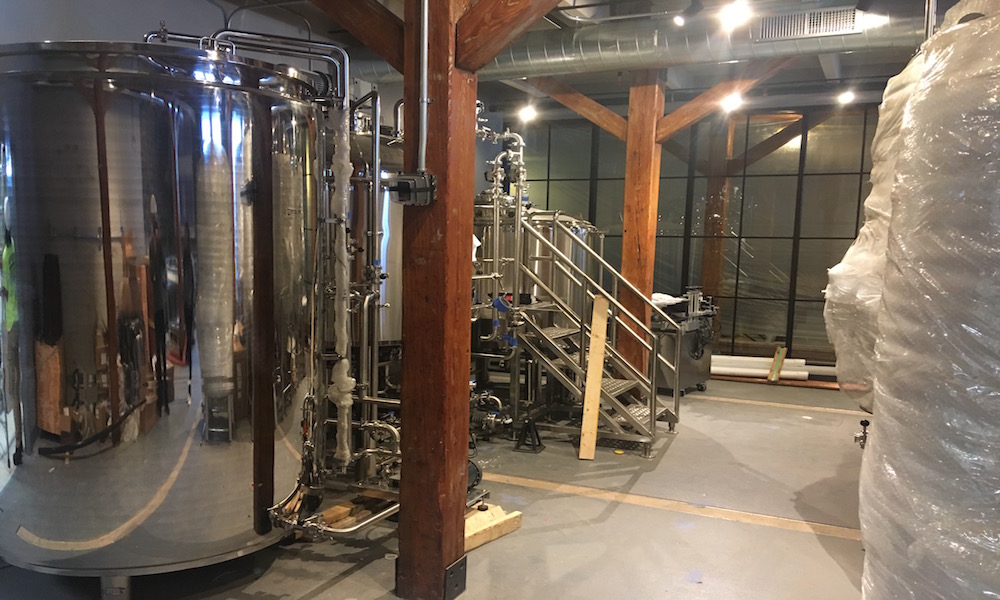
The second floor of the building, the “Walt” space, will be converted into an upbeat café, open from 7am-7pm, and offering hot breakfast items and grab-and-go eats. A variety of kombucha, nitro, cold-brew and hot coffee, provided by Baltimore’s Ceremony Coffee Roasters, will all be available and on tap, no less, via a new, built-in Modbar coffee system. “We put a lot of thought into who was going to provide our coffee,” says Jenks about the decision to go with an out-of-town company. “Ultimately, we really wanted to enhance the local coffee scene, and Ceremony Coffee Roasters have great sustainability practices, and they just put out really good coffee.”
Originally slated to open this past summer, Walt + Whitman experienced a number of delays due to asbestos and some structural problems with the historic Saratogian Building, which was constructed, originally out of wood, in 1902. “It was a lot of added emotion to know that we were going to have a chance to restore the building, but it also delayed us about a year,” says Jenks. Saratoga’s Bonacio Construction has been leading the ambitious restoration effort, and, though the space is still under construction, the results of the renovated interior are already evident. (I was given a walkthrough on October 4, and the results of the renovated interior reveal a sprawling space with antique red-brick walls and the beginnings of bars and counter spaces, some even fashioned from pieces of repurposed wood, recycled from the original structure.)
It certainly hasn’t been an easy road forward, but Walt + Whitman’s team knows they have something special on their hands. “Every time we thought about walking away from this, we told ourselves this was the dream,” says Jenks. “It was a dream having this in the center of downtown, being a beacon for Saratoga and supporting the tourism industry and the locals.” The Saratoga native is feeling very optimistic about the new venture, which after so much hard work is finally on the cusp of its grand opening. The cafe (“Walt”) section is scheduled to open on Friday, December 6 with the taproom opening later that same week.
Local Farms Star At Annual Feast Of The Fields Fundraiser
On Thursday, September 19, more than 500 guests joined in celebration of local food at Saratoga PLAN’s 14th annual Feast of the Fields fundraiser at Saratoga National Golf Club. With dozens of farm-to-table tasting stations featuring twelve chefs, a multitude of drink vendors and live music from the Hot Club of Saratoga, attendees had a ball of a time tasting everything from tacos to oxtail sliders, and everything in between!
Saratoga PLAN is a nonprofit land trust dedicated to preserving the scenic and natural beauty of our lovely city. This year’s Feast of the Fields raised $120,000 to support conservation projects in Saratoga County. Each of the participating vendors celebrated the local wonders of the agricultural community by sourcing all their ingredients for the event from a total of more than 70 farms within a 100-mile radius of Saratoga. And, in an effort to curb waste and benefit another area nonprofit, chefs donated the leftover food to Shelters of Saratoga, spreading the good work of Saratoga PLAN even further.
“Creating the connection between farm and fork, and, as a result, between farmer and neighbor, is one of the most rewarding parts of our work,” says Alex Fylypovych, PLAN’s Community Engagement Manager. “As the community’s connection to the land strengthens, so does their concern and desire to conserve it.”
In addition to fresher-than-fresh dining, the event also included live and silent auctions, which saw items, such as a Bianchi Touring Bike from Adirondack Ultra Cycling, a beach getaway in Sanibel Island and the original artwork for the Feast of the Fields invitation by local artist Elisa Sheehan, go for top dollar. Some $30,000 was raised for PLAN internship and stewardship programs. “Now, more than ever, it’s critical to educate the next generation of conservationists,” says Flylypovych. “Guests’ donations on Thursday night are giving us that opportunity.”
100-Inning Charity Baseball Game To Be Played To Help Fund A $2500 Baseball Scholarship At SUNY Schenectady
One group of locals is hoping that Capital Region baseball fans will come out to a ballgame that’s 91 innings longer than usual—for a worthy cause, of course. The 100-inning game, which organizers are hoping to pull off in just four hours, takes place at the Central Park “A” Diamond (a.k.a. Buck Ewing Field) in Schenectady from noon to 4pm on Saturday, October 5.
The game was conceived to raise funds towards a $2500 college scholarship for a baseball player attending SUNY Schenectady. The fundraiser/scholarship honors the lives of Tim Andi, who was the baseball coach at SUNY Schenectady for 25 years and passed away this past March; his son, Ryan, who lost his battle with cancer in 2016; and Tim’s wife, Cathy, who unexpectedly passed away in September. “Tim put so many kids that went through community college into a position to attend and play ball at four-year schools,” says Steve Mittler, Tim’s daughter Shannon’s partner. “[But] the event’s really to honor all three of them now.”
Donations are being accepted on the Tim and Ryan Andi Scholarship Fund’s Facebook page, launched by Tim’s former student Dominick LeMorta, which has already raised nearly $1500. Game organizers are also selling spots in the main event for $30 per local ballplayer, with all the proceeds going towards the scholarship fund. During the game, there will also be barbecue and soda for spectators, as well as a pregame reception from 6-10pm on Friday, October 4 at Schenectady’s Backstage Pub (near Proctors).
Actually, this isn’t the first 100-inning ballgame that’s been pulled off in the Electric City. Back in 2015, Tim organized a marathon game to help offset travel and medical costs for his family, while his son Ryan was battling cancer at Boston Children’s Hospital. Recruiting many of his former and then-current students to play ball for a good cause, Andi ended up raising $10,000. (Tragically, Ryan passed away the following year.) And just a couple of years later, Tim found himself in need of assistance, too, as he battled a rare autoimmune disease. Many of the same players who participated in the ’15 game organized another one to help him offset the cost of treatments.
While the game is billed as a 100-inning affair, Mittler notes that past games haven’t quite hit the century mark, with players usually reaching the low 90s by the end of four hours. But at the end of the day, it’s the fun, camaraderie and cause that really matter. “We want to celebrate Tim and his wife and son at a happy place versus a funeral,” says Mittler.
Spa City Community Throws Its Support Behind Family Of Fallen Saratoga High School Graduate
Saratoga Springs is a giving community. (But you already knew that, didn’t you?) And when one of our own is in need, we do everything in our power to help them out. Case in point: When a multi-car collision totaled the Saratoga Awesome Dogs food truck in late August, a customer stepped in and launched a GoFundMe page to help get its owners back up and running again. (They were back in business in mid-September.) My wife and I have been touched by Saratoga’s own Joy US Foundation, which has helped us cope with a cancer diagnosis and brought literal joy back into our lives through its various outdoor programs for survivors and their families. And of course, you can just scroll through all the incredible galas and fundraisers that city organizations host each year to get an even clearer picture of how generous we all are.
Saratoga’s extended family is at it again, this time for a fallen friend and classmate. On September 24, 42-year-old Joe Lane, a graduate of Saratoga Springs High School (class of ’95)—and whose mom ran the popular Downtown Saratoga pizzeria, Gina’s Pizza—died of an unexpected medical complication, leaving behind a wife and two young children. (Lane’s father-in-law was my orchestra instructor throughout high school, his sister-in-law, a friend and fellow musician.) To make matters worse, due to a preexisting condition, Lane’s life insurance benefits were limited at best.
So friends and fellow Saratogians Ken Kwalik and his sister, Keriann Kwalik Gregor, have set up a GoFundMe page to help support Lane’s family. (Lane was Kwalik’s best man in his wedding.) One-hundred percent of the money raised will go to Joe’s wife and will help supplement her children’s future education. At present, the page has already raised more than $70,000 for Lane’s family. Saratogians interested in making larger, individual donations are being urged to contact Kwalik directly via email ([email protected]).
Comic Depot, Saratoga’s Only Comic Book Store, Closes Its Doors For Good (Exclusive)
It’s about to get a little more difficult to go comic book hunting in Saratoga Springs. The Spa City is losing its only dedicated comic book shop—and one of only a few throughout the Capital Region—the Comic Depot, which currently sits on the first floor of the Algonquin Building at 514 Broadway. The local comics and collectibles business, which also sold games, trading cards and regularly held tournaments and other gaming events, spent its final day in business on Wednesday, October 2, with a storewide sale.
“It’s been a madhouse for the past week,” says Comic Depot’s Manager Chris Kaminski, who noted that there’d been a surge in business since the shop announced its closing on social media last week. The store’s sale continued through the day, with 30 percent off all wall books and back issues (over $5.99) and 20 percent off all gaming equipment and Magic the Gathering products. “It’s been a heck of a ride,” says Kaminski. “We’re very grateful to be a part of this community and have the friendships that we made from being in this business.”
Founded in Greenfield in 2003, Comic Depot spent two years at the Wilton Mall before moving to its final location on Broadway in November 2013. The store was slated to close late last year, but that was delayed when the shop changed owners in an 11th-hour deal with Jeff Watkins of Cloud City Comics in Syracuse. However, rising rents on Broadway and increased competition from online markets such as Amazon proved too much for the local small business. “It was great for us to have those extra months, coming in and running the shop a little bit longer than intended,” says Kaminski, who’s worked at the store for seven years. “It never seemed like work because it was something we loved.”
Though it won’t be opening another storefront elsewhere, the shop will continue to update Comic Depot’s Facebook page for former customers still interested in connecting over comic books and trading cards.
Saratoga’s Water: The Story You Have To Read
In the opening scene of Ice Age: The Meltdown, Scrat, the acorn-obsessed saber-toothed squirrel, is hanging off the edge of a glacier where his acorn has become lodged. When he finally wedges it out, a stream of water springs from the hole. He plugs the leak with his paw, but another springs, followed by another and another until he runs out of body parts to plug the leaks with and is blown from the side of the glacier.
That’s what writing about water is like. Every time you think you’ve done it—plugged the leak and contained the tsunami—another leak, or, in this case, lead, sprouts. There’s e. Coli in the lake. Great. On top of it. But, oh wait, it also has blue green algae and zebra mussels, and there are invasive water chestnuts in the creek that connects the lake to the river. There’s the water crisis in Africa, in California and in the Colorado River basin, and then there’s the drinking water crises in Flint, MI and Newark, NJ. There’s saltwater and fresh water, glacial water and rainwater and, in Saratoga Springs, there’s mineral water.
In writing about all the waters of Saratoga, and actually, in writing about Saratoga in general, mineral waters come first. As Dr. Grace M. Swanner writes in her Saratoga Queen Of Spas (the book Saratoga Room Library Clerk Victoria Garlanda referred to as “The Bible” when she handed it to me), “It can realistically be said that the waters are the veritable ‘raison d’être’ of Saratoga Springs.” And so, in my quest to write as comprehensive a story on Saratoga water as possible, mineral water is where I’ll dive in first.
First, a quick and (somewhat) dirty history: The Saratoga region was originally a prime hunting ground for the Mohawk Indian tribe, whose members believed the waters that bubbled from the ground were a gift from the god Manitou. European settlers came in in the early 1700s, claimed the land and began developing it. In the 1800s, Saratoga was a destination for the rich and famous, who came to “take the waters” (drink from the mineral springs), but by the end of the century, private industry had begun extracting carbonic acid gas from the springs for use in soda, which was detrimental to the natural flow of the springs. The State of New York stepped in in the early 1900s, passing anti-pumping legislation, but not before many of the springs had been permanently damaged. Shortly after, in 1909, the State Reservation at Saratoga Springs was formed, which put the future of the springs solely in the state’s hands, followed by the creation of the “New Spa,” a European-style health center that became the first major project finished under Franklin Delano Roosevelt’s New Deal, in 1935. The Saratoga Spa saw its finest hour between then and 1950, after which its funding was gradually cut, and it was transformed into the Saratoga Spa State Park we know today.
I made several trips to the Spa State Park this past summer, the first of which was to explore the benefits of soaking in Saratoga’s mineral waters by way of a spa day—solely for research purposes, of course. Established in 1935, Roosevelt Baths & Spa is the last remaining historical bathhouse in Saratoga Springs, and bathing in the carbonated waters of the Lincoln Spring—just as guests did back in the days of the Saratoga Spa—is its signature treatment. Benefits of such mineral baths, Spa Director Jared Taisey tells me, are believed to include therapeutic effects on skin conditions such as psoriasis, increased blood circulation and cell oxygenation, stimulation of the immune system, production of endorphins, normalized gland function and promotion of feelings of physical and psychological well-being. “Of course, everything is a belief—we can’t say for certain,” Taisey says.

That got me thinking: How do we not know for certain? Hasn’t there been some study that definitively proves (or, gasp!, disproves) bathing in mineral waters has medicinal value? It turns out, there hasn’t. Academic study after academic study I reviewed all said some version of the same thing: There was “insufficient evidence” to support the fact that balneotherapy (the treatment of disease by bathing in mineral springs) was effective. In reading these studies, I came across the name Arianne Verhagen quite a bit, and decided to reach out to her to see what the deal was. “I do not think that, at the moment, the scientific world is able to state that balneotherapy is or is not effective,” says Verhagen, professor and head of the discipline of physiotherapy at University of Technology Sydney and whose research delves into the effect of balneotherapy on physiological impairments. “There are just not enough studies done of a certain size and quality to be able to draw these kinds of conclusions. I’m not sure why these studies are not performed, but I assume it’s a money problem, as these studies cost a lot of money, and probably researchers cannot find the funding for them.”
So, without scientific evidence to back the legitimacy of balneotherapy, we’re left with anecdotal evidence, which, it turns out, is in high supply. For starters, you can’t ignore more than four centuries of Saratogians and visitors to the Spa City who believe in the water’s healing qualities. One high-profile example is Zac Brown Band bassist Matt Mangano, who told saratoga living that running mineral water over his dislocated finger made it feel good enough to play a show at Saratoga Performing Arts Center (SPAC) that same night. Then there are the people who can speak to the increased feelings of psychological wellbeing: “We hear from a lot of our guests that after they have a mineral bath, they didn’t care that their cell phone was going off, or they shut it off because it was going off,” Taisey says. “Like, the world’s gonna survive for the couple hours that they’re spending here at the spa.”
That psychological wellbeing is key. “Given the right environment and the psychological assurance that health will be restored, the salutary physiological effect of the waters and minerals necessary for rebuilding body tissues will accomplish wonders,” Dr. Swanner writes. “This concept is basic to spa therapy. The mineral waters are not necessarily specific for any given disease. They contribute to the basic welfare of the person by improving the general health and thereby aiding nature in the natural healing process.” The other explanation for why people who came to the Saratoga Spa felt—and were, according to many studies conducted in the era—healed, is that “spa therapy” also included a regiment of exercise, healthy diet, rest and recreation.
So, while I can’t say I felt healed in any specific way by my mineral bath at Roosevelt (being in my 20s, I don’t have too many ailments in need of healing), it’s hard to imagine my relaxing soak, when paired with a healthy diet and exercise, would do me any harm. If anything, for the remainder of the day I went to the spa, I felt like I was still floating in that one-of-a-kind, effervescent water.
But bathing in mineral waters is only half of the equation; from Victorian Era tourists who came here to “take the waters,” to those who, while at the Saratoga Spa, drank from the Hathorn, Coesa and Geyser springs, which were piped into the Hall of Springs, Saratogians and visitors alike have been drinking from the “health-giving” mineral springs that dot Saratoga Springs for hundreds of years. So, I figured I’d see what all the fuss was about.

Upon my arrival at the notoriously delicious State Seal Spring across from the Saratoga Automobile Museum, I filled my Nalgene and, too nervous to sip it in front of all the people standing around filling their five-gallon jugs, made like I was leaving. But that’s when I met Willow, a pup whose owner, 15-year Gansevoort resident David Dinallo, looked like a regular around those parts. “It’s the best water I’ve ever had,” Dinallo said about the State Seal. “I consider Fiji the benchmark of water, and this is right up there. The thing is, this water is free and Fiji costs $39 at BJ’s.” (Ironically, and devastatingly, I found out later, Fiji, home of the trendy Fiji bottled water brand Dinallo mentioned, is actually one of the worst-off countries in the world when it comes to water access—but more on that later.) “Twenty years ago, who would’ve ever bought water in bottles at the store?” he asked. “Now, most people won’t drink water out of the tap. But water from bottles isn’t much better, I hear.” Willow likes the State Seal water too: Several times, Dinallo put two bowls of water on the ground, one filled from the tap and one filled with State Seal water, and eight times out of ten, Willow drank from the State Seal bowl.
I broke the news to Dinallo that I’m a water-from-the-ground newb, and of course, he wanted me to try it, right then and there. But by then I’d realized people were waiting for a spigot and not getting water from the one I filled my bottle with. That’s because the one I chose was actually churning out good old-fashioned mineral water from the Geyser Spring. (The words “mineral water” are actually engraved in the concrete above the spigot—not sure how I missed that.) But Dinallo insisted I try that too. “It tastes like blood,” an onlooker warned. I swished it around in my mouth and spit it out. It tasted like blood.
The blood taste comes from iron in the water, I learned later. But not all the springs taste like that. That’s because, while all the mineral springs contain the same minerals—such as potassium, calcium and magnesium and, yes, iron—and are therefore believed to be from the same source (though that source is not officially known, Saratoga Spa State Park Manager David Guest tells me), they have varying concentrations of those minerals. Historically, the health benefits of the springs were also thought to vary. Congress Spring in Congress Park, for example, is categorized as cathartic and was thought to benefit dyspepsia, gout and skin ailments.
I ask Dr. Judy Halstead, a professor of chemistry at Skidmore College, her thoughts on the medicinal value of Saratoga’s mineral waters. “No, they’re not medicinal!” she flatly tells me. “No, no, no, no!” She explains: “When we say mineral, it means it’s got calcium and magnesium in it. It’s also gonna have a lot of sodium in it. So, anyone who’s concerned about their sodium consumption—you certainly don’t want to be taking mineral water. They’re also radioactive. Not to the point where they would be dangerous, but I can’t imagine any reasonable argument to just decide to consume a bunch of minerals, a bunch of salt and a little bit of radioactivity. That’s crazy.” Halstead ventures that perhaps tourists in the Victorian Era saw improvements in their health when they came to Saratoga not necessarily because of the mineral springs, but because of the regular drinking water. “Our surface water may have been somewhat cleaner long, long ago than if you were living in New York City or Philadelphia, where it’s easy to see that surface water would’ve been heavily polluted.”

There are some springs, though, that don’t have as much salt, radioactivity, calcium or magnesium, or at least not in as high quantities, and are therefore not classified as “mineral.” One is the State Seal (which actually spews sand-filtered rain water) and another is the Sweet Water Spring, which, located across Route 50 from State Seal and the rest of Spa State Park, is the main source for Saratoga Spring Water, the company behind those blue glass bottles you see everywhere around town. (Pristine Mountain Springs in Stockbridge, VT, which has very similar characteristics as Sweet Water Spring, is the other source.) The identity of Saratoga Springs is undoubtedly tied to Saratoga Spring Water. Besides the obvious name-related similarities, Saratoga Spring Water is the last remaining bottler of Saratoga’s spring waters, having been in operation since 1872. Its iconic blue bottles have also, in a way, become synonymous with Saratoga—not only are they sold in 30 states and 5 countries, which puts Saratoga on the map as a “water” destination even after the closing of the Saratoga Spa, but Saratoga Spring Water souvenirs are a signature item in shops up and down Broadway (I’m the proud owner of a candle holder made out of half a Saratoga Spring Water bottle). “I think right now we have a symbiotic relationship with Saratoga where people might have a nostalgic view of their visit to Saratoga,” says Saratoga Spring Water President Adam “AC” Madkour. “They see our bottle on the shelves, and it brings them back to that time they were here. We’re getting the name Saratoga out across the country and around the world, and then, at the same time, those people who have all those great memories of visiting this area can have a little piece of that when they see our bottle.”
OK, time for a water break. Have you already had your two liters for the day?
With the storied history of Saratoga’s spring waters, and the national and international attention its premier bottled water brand has garnered, it makes sense to assume its drinking water supply is equally noteworthy. Rumors even swirl in Manhattan that New York City’s water is as good as it is—and makes the city’s pizza dough and bagels as good as they are—because it gets water from Saratoga Springs. (The tasty NYC tap water actually comes from a watershed in the Catskill Mountains, which have very little limestone rock and therefore don’t taint the water with bitter-tasting calcium.) But in reality, Saratoga’s spring waters are a completely separate entity from its drinking water. Whereas the mineral springs arise from waters trapped in layers of impenetrable rock deep below the earth’s surface and rise along fault lines, Saratoga’s main municipal water source is Loughberry Lake, a shallow reservoir next to Route 50 between Saratoga and Wilton. The city also uses ground water from the Geyser Crest system, as well as from Bog Meadow Brook and three Bog Meadow ground water wells during the summer months when water is in higher demand.
Drinking water is obviously a hot topic right now, given the crisis in Flint, MI and now Newark, NJ relating to lead in drinking water, as well as the water insecurity seen around the world from Africa to California and Fiji, where 53 percent of people don’t have access to safe drinking water. (It’s literally easier to get water from Fiji in any city in America than it is in Fiji itself.) “Flint has brought water to the forefront,” says Brett Johnson, chief water plant operator for the City of Saratoga Springs. “People are more educated because it’s been in the news. They’re worried their kids might get lead poisoning.”

But Saratogians have nothing to worry about. Whereas contaminants such as chloride, nitrogen and mercury may be present in source water (i.e. Loughberry Lake) as a result of runoff from fertilizers, road salt or factory waste, and can therefore be treated at the plant, lead, which when ingested, severely affects mental and physical development, typically gets into drinking water after it leaves the treatment plant in the pipes that bring it to people’s homes. While most of the pipes transporting water under the City of Saratoga aren’t made of lead, there are a few, and in a routine water test in June 2017, lead levels were found to exceed the legal limit in 7 out of 60 homes in the city. As a result, the Department of Public Works worked with the New York State Department of Health and an engineering firm to test and subsequently introduce orthophosphate, a substance that prevents lead from leaching from pipes into water. (In Flint and Newark, many more homes are serviced by lead pipes, and both cities misused, or failed to use, corrosion inhibitors such as orthophosphate to prevent leaching.) Subsequent tests in November 2017, May 2018 and November 2018 in Saratoga found that lead had fallen below the maximum contaminant level.
Water scarcity is another issue—actually, one of the biggest issues—that communities around the world face today. While about 70 percent of Earth is covered in water, only about 2.5 percent of that is fresh water. (Saratoga isn’t coastal, so, thankfully, I’ll be leaving the discussion of ocean pollution, coral reef depletion, water levels rising, etc. to some other lucky reporter.) Even then, only one percent of Earth’s fresh water is easily accessible—most of it is trapped in glaciers (another topic I won’t be touching on, aside from in that Ice Age metaphor in the intro) and snowfields. According to the United Nations, in 2015 three in ten people didn’t have access to safe drinking water, including some in California, which was in the midst of a seven-year drought. (It turns out, the water shortage in California had less to do with the drought than it did with rich agriculture corporations hogging all the available ground water, but again, I’ll abstain from getting into that.) By 2025, the World Health Organization estimates that half of the world’s population will be living in water-stressed areas. That’s in five years.
While Saratoga hasn’t had any real issues with water scarcity in the past, the city is safeguarding against future problems. On a tour of the Saratoga water treatment plant (which has been in operation since 1935, the same year the Saratoga Spa and Roosevelt Baths & Spa were completed), Johnson pointed out a 1.5 megawatt generator that was installed in 2015 and is capable of running the facility at full capacity, as well as a gauge monitoring the water level of a 5 million-gallon storage tank located behind Skidmore College (it’s almost full, FYI). He also told me the city has a bid out for a study of Loughberry Lake that will determine the long-term viability of its water quality and safe yield, or in other words, if it will continue to be a reliable water source for the city in the coming years.
While Loughberry Lake just so happens to be Saratoga’s drinking water source, it’s first and foremost a lake. And as a lake, it’s susceptible to the same threats as Saratoga’s other surface waters—threats such as invasive species, contamination and eutrophication (when a body of water becomes overly enriched with nutrients).
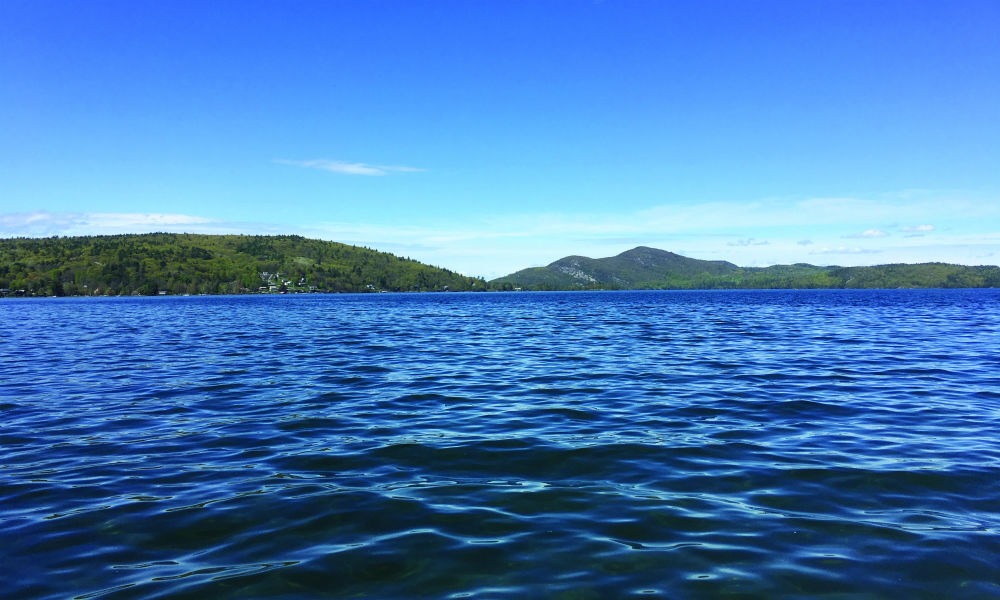
Let’s break that down. Invasive species, ones that are not originally from the area and cause environmental and/or economic damage, are a pretty straightforward problem. Zebra mussels and water chestnuts are the two main culprits in Saratoga County: The mussels compete with native fish for food and clog industrial water pipes, and the chestnuts develop into thick mats that block sunlight from native species and hinder activities such as swimming, boating and kayaking.
The obvious example of contamination of waters in the area would be when General Electric dumped around 1.3 million pounds of Polychlorinated biphenyls (PCBs) into the Hudson River in Hudson Falls, NY and Fort Edward, NY between 1947 and 1977. The now-banned substance had unintended impacts on human and environmental health, and can now be found in water, sediment, wildlife and people as far south as the New York Harbor. Road salt is another contaminant, which affects aquatic life and decreases water clarity, as is E. coli, which gets into water by way of animal feces or untreated sewage. This August, Brown’s Beach on Saratoga Lake was closed due to E. coli contamination from what was thought to be geese droppings from a flock that passed over the beach.
Besides E. coli, feces also contain nutrients, which, when they enter bodies of water, speed up eutrophication. “Natural eutrophication is the process by which a brand-new, pristine, geologically pure, young lake gradually and naturally becomes a swamp and then land,” Halstead tells me. “That’s a natural process. But when we add certain things, particularly nutrients like nitrogen and phosphorus, to a body of water, that can accelerate it dramatically.” It happens like this: Nutrients, such as sewage or fertilizers, get into a water body by way of rainwater runoff and feed algae, creating algal blooms, which block sunlight causing plants to die. Then, bacteria digest the dead plants, using up oxygen in the process, and fish die, because they can’t survive without oxygen. It goes without saying that the recent repeal of a major Obama-era clean water regulation that put limits on the use of polluting chemicals, such as fertilizers, near bodies of water, is not good news for the health of surface water.
Obviously, invasive species, contaminants and eutrophication are important to the health of lakes and streams that aren’t a source of drinking water: When lakes are contaminated, their water can make people or animals sick and negatively impact tourism. But drinking water is still a chief concern. As of now, none of these issues pose a threat great enough that the Saratoga Springs water treatment plant can’t handle. When I was there, Johnson showed me all kinds of charts and meters that are constantly monitoring the levels of coliform, turbidity, inorganic compounds, nitrate, nitrite, lead, copper, volatile organic compounds and many more things I can’t even pronounce, in the city’s water. And still, some residents don’t trust it. “You know how old the pipes are…they’re not too hot,” says Saratoga Springs resident Justin Metzger. “Some of them are still wood if I’m not mistaken.” (Johnson told me this is “highly unlikely.”) Nick LaRose is another city resident who refuses to drink water from the tap (and who also happens to be my boyfriend). “You don’t know what they’re putting in it,” he says. “Fluoride? Fluoride’s not good for you. That Flint water crisis? The people were just drinking the water. And it had more lead in it than a Ticonderoga pencil factory.” (While the Centers for Disease Control and Prevention considers water fluoridation as one of the ten great public health achievements of the 20th century because of its contribution to the decline in the public’s tooth decay, the relationship between fluoridated water and cancer has been debated for years. And Ticonderoga uses graphite in its pencils, not lead.)
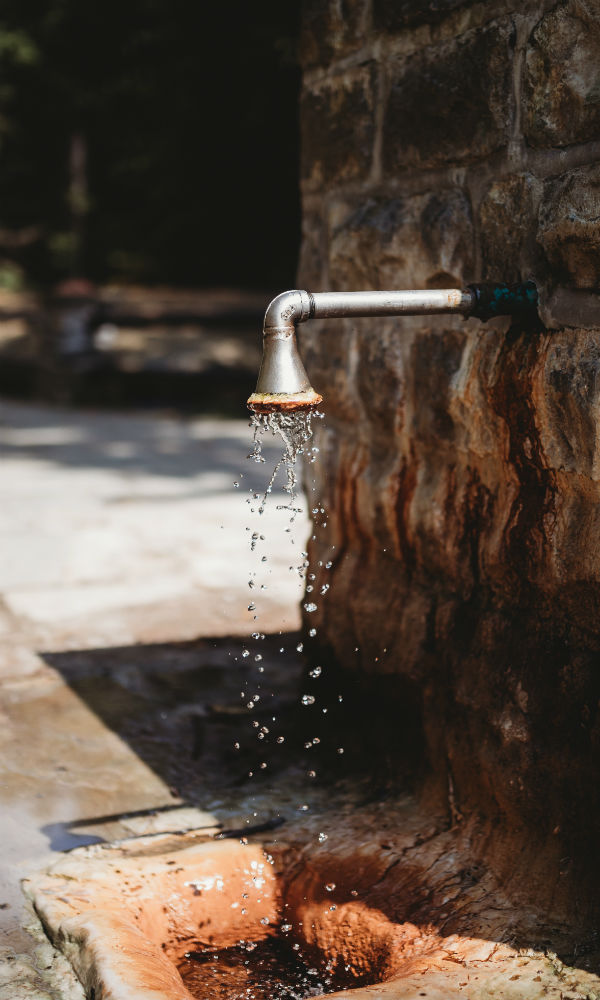
State Seal water, though, LaRose says, he’d drink. “That’s what people did for thousands of years,” he says. “They didn’t put chemicals in the water in ancient Rome.” (The average life expectancy in ancient Rome was 25.) Dr. Halstead is not of the same mindset. She tells me she came across a blog post by a woman who said she saw someone letting their dog lick the spigot at the State Seal Spring. “How do you know what anybody’s been doing there?” Halstead says. “Honestly, really, I’m happy the parks and recreation people test it. I think I found a Post Star article that said they test it quarterly. Well that’s every three months. But really, do you want to drink water that’s been tested for bacteria every single solitary day and is filtered and disinfected”—as Saratoga city water is—“or do you want to be drinking your water from someplace a dog could’ve just been licking the faucet?” (In addition to the quarterly tests mentioned in the 2010 Post Star article Halstead was referring to, Guest tells me “The mineral spring water is collected and taken to an outside lab for analysis monthly.”)
But tap water doesn’t taste good, some people will say (not me—I have no problem gulping down Saratoga city water). Well, there are a couple of options. For one, you can buy a filter, such as a Brita, which a lot of Saratoga residents I talked with have. The issue there, Halstead says, is you’re putting extra responsibility on yourself that you were previously trusting the water plant with to change the filter frequently enough so that bacteria doesn’t grow in it. The other option is to just put a pitcher of your tap water in the fridge for a while before drinking it. “If you give it 12 hours or something, most people, even if they don’t like the taste of the local water, will find it to be more agreeable the next day,” she says.
Dr. Halstead, ever the tap water champion (though she does admit things can get sloppy, as they did in Flint), goes on to tell me that while tap water is regulated by the Environmental Protection Agency and State of New York, bottled water is regulated as a food by the Food and Drug Administration, and has minimal testing requirements. “Bottled water is something like 1000 times more expensive than tap water,” she continues. (It’s actually 3785 times more.) “You can get organics leaching out of the plastic bottle, the contribution to global climate change, the pollution from having to get rid of the bottles, the environmental impact of transporting those bottles, you’re making the plastic bottles…it’s just ridiculous.” Madkour and Saratoga Spring Water recognize these environmental issues and are working to combat them. “We realize what industry we’re in, and by focusing our business on glass containers, we believe that that is a more sustainable option. They have better recyclability, better durability and in conjunction with that, we offset all of our power usage with wind power so that we can be a carbon neutral operation.”
The very first person I talked to when I started my water investigation was Elizabeth Sobol, president and CEO of SPAC. Not the most obvious choice, I know. But I knew she was passionate about water—mineral and drinking—as evidenced by her bringing a three-part series of talks on water to SPAC this past summer. (I made it to the third installment of the series, a talk by Charles Fishman, author of The Big Thirst: The Secret Life And Turbulent Future Of Water, at the very end of my months-long water exploration, and, as expected, it sprouted countless more glacial leaks/leads, from wastewater and gray water, to the innovative ways water scarcity issues are being solved around the world.) “People hear me talk about it all the time: I look at SPAC as the perfect confluence of manmade beauty and natural beauty,” Sobol says. “There are certainly many other summer festivals that are located in beautiful locations—Tanglewood is the obvious example. But no other summer music festival of this magnitude is so specifically located in a park that was created around the presence of healing waters.”
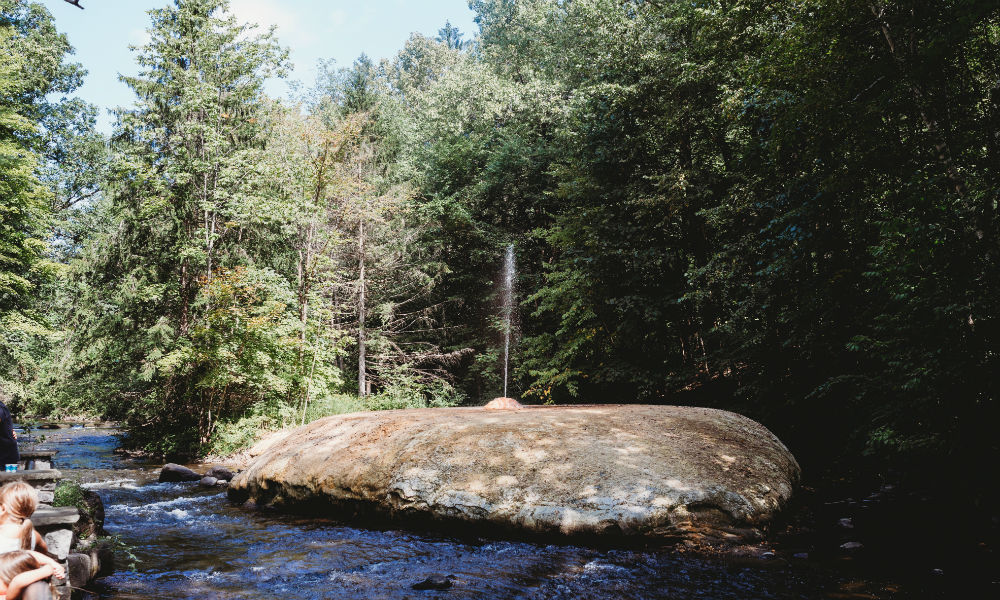
Sobol is helping to further highlight the presence of the springs in the Spa State Park with the renovation of the long-vacant Roosevelt II bathhouse. “Coesa [a wellness retreat center] will go in there, we’ll have a gallery space and a black box theater space and teaching kitchen and workshop and classroom space,” she says. “We’re essentially going to be breathing new life and purpose into a building that was originally built to take advantage of the waters and their healing properties.”
Sobol also talked about The Jefferson Project, a partnership between the FUND for Lake George, IBM and Rensselaer Polytech Institute (RPI) that is the world’s most advanced environmental monitoring system. The project’s goal is to identify, understand and respond to ecological stressors (which are often human caused), such as road salt, invasive species and excess nutrients (or eutrophication), in order to create a global model for ecosystem resilience. “I think it’s incredible that all these people and organizations are getting together, seeing the responsibility they have to help create templates for the future and for other people who are trying to stave off the same problem,” Sobol says.
I knew from previous interviews Sobol has done with saratoga living that when she moved here from Miami Beach to take over SPAC in 2016, she was at least, in part, swayed to come by the natural beauty of the area, so I asked her about it. “That fateful, cool, June evening when I came up here for the first time, I walked by Congress Park and the beauty of the fountain and the springs…the water there was just so riveting and beautiful and seeing the springs there made me curious. I suppose Congress Park, and the water in it, was the first thing about Saratoga Springs that really, totally arrested my attention.”
In my effort to wrap my head around water—it’s just two hydrogens and an oxygen, after all—I asked Sobol where, in her opinion, the topic of Saratoga’s mineral water meets drinking water meets surface water. “At the end of the day, if we’re not working together and we’re not acknowledging the interconnectedness of our own lives and water and how we’re connected to the earth, then it’s not a pretty future,” she says. “I think it’s that interconnectedness piece that, for me, makes it all not just interesting and fascinating, but also critical and urgent.” It seems like some special sort of destiny that, when Saratoga’s springs attracted the environmental, artistic, civic force that is Elizabeth Sobol to our little city, we had no idea that in addition to transforming SPAC, she’d be one of the most dominant voices advocating to save—and celebrate—our water.
Saratoga Water: The Numbers
13 The number of springs in the Saratoga Spa State Park
250 The minimum number, in parts per million, of dissolved solids such as calcium, magnesium, sodium and potassium that must be present in water for it to be considered mineral water
750,000 The amount, in dollars, the new Lincoln Bath House cost to build (it opened in 1930)
92 The percentage of patients with arthritis and related conditions who showed definite improvement after taking part in a special treatment program which included the use of naturally carbonated mineral waters in the form of baths and other forms of spa therapy during a study at the Veterans Hospital at Saratoga Springs from 1943-1947
107,299 The number of treatments given at the Lincoln and Washington bath houses in 1927
15,000-20,000 The approximate number of mineral baths given at Roosevelt Baths & Spa per year in recent years
2690 The amount of sodium, in milligrams per liter of water, in water from the Hathorn #3 Spring in the Spa State Park
2300 The recommended maximum daily intake of sodium, in milligrams
147 The number of years Saratoga Spring Water has been in business
30 The number of states Saratoga Spring Water is sold in
5 The number of countries Saratoga Spring Water is sold in
28,000 The approximate number of people the Saratoga Springs water system serves
1,530,219,000 The total amount of water, in gallons, produced in Saratoga Springs in 2018
7,066,000The amount of water, in gallons, consumed in Saratoga Springs on July 2, 2018 (the year’s highest single-day consumption)
1.72 The approximate amount, in dollars, Saratoga residents paid per 1000 gallons of water in 2018
31 The percent water bills in the US have surged since 2012 (vastly outpacing US inflation)
15 The “action level” of lead, in parts per billion (the maximum concentration of lead allowed in drinking water before the system must take action to control corrosion in pipes)
13,000 The highest level of lead, in parts per billion, found in Flint, MI during its water crisis
0.007 The percentage of the planet’s water that’s available for human use and consumption
30 The percentage of people worldwide who didn’t have access to safe drinking water in 2015
50 The estimated percentage of people worldwide who will be living in water-stressed areas by the year 2025
5000 The number of children who die each day from lack of water or diseases they got from tainted drinking water
9.6 The amount, in millions of dollars, the states of New York and Vermont have spent on controlling invasive water chestnuts over the last 29 years
1.3 The amount, in millions of pounds, of Polychlorinated biphenyls (PCBs) that General Electric dumped into the Hudson River between 1947 and 1977
33 The percentage of students who correctly identified a tap water sample from Vermont Pure bottled water in a 2011 study
100 The number of times more air and water pollution created by making a 16-ounce water bottle from plastic polyethylene terephthalate (PET) than are created by making it out of glass
3785 The number of times more expensive single-serve plastic water bottles are than tap water when priced by the gallon (some bottling companies, such as Dasani, actually draw on municipal water supplies)
1.63 The number of liters of water Coca-Cola bottling plants, which produce Dasani, use for every 1 liter of beverage produced
2 The number, in billions, of plastic water bottles purchased by Americans each week (that’s 6 bottles per person per week)
2 The amount of water, in tablespoons, used to complete one Google search (with 4 million searches conducted a minute, Google uses 45 million gallons of water a day)
4.9 The number of gallons of water it takes to grow one walnut
18.5 The amount of clean water, in gallons, flushed down the toilet by each American every day
250 The amount of gallons of water it takes to provide electricity for one American each day (that’s 2.5 times more water than the average American actually uses in the kitchen and bathroom each day)
1 The amount of Poland Spring and Dasani bottled water, in millions of gallons, Americans drink every hour
73 The minimum number of terabytes of data generated by Jefferson Project computer models each year
51 The number of Jefferson Project sensor platforms in or around Lake George
11 The number of gallons of water present in a 150-pound man’s body (that’s 90 pounds worth!)
(13) DAVID GUEST; (250) FOOD AND DRUG ADMINISTRATION; (750,000, 92) SARATOGA QUEEN OF SPAS; (107,299) SARATOGA QUEEN OF SPAS; (15,000-20,000) JARED TAISEY; (2690) NEW YORK PARKS, RECREATION AND HISTORIC PRESERVATION; (2300) THE AMERICAN HEART ASSOCIATION; (147) SARATOGA SPRING WATER; (30) AC MADKOUR; (5) SARATOGA SPRING WATER; (28,000, 1,530, 219,000, 7,066,000, 1.72) CITY OF SARATOGA SPRINGS; (31) CBS; (15, 13,000) THE WASHINGTON POST; (.007) NATIONAL GEOGRAPHIC; (30) UNITED NATIONS; (50) WORLD HEALTH ORGANIZATION; (5000) THE BIG THIRST; (9.6) SARATOGA PLAN; (1.3) US ENVIRONMENTAL PROTECTION AGENCY; (33) BOSTON UNIVERSITY; (100) BERKELEY PLASTICS TASK FORCE; (3785) MONEY CRASHERS; (1.63, 4.9) MOTHER JONES; (2, 2, 18.5) CHARLES FISHMAN; (250, 1, 11) THE BIG THIRST; (73, 51) THE JEFFERSON PROJECT
Hiding In Plain Sight: Mills Entertainment, A Division Of Hollywood Juggernaut CAA, Is In Downtown Saratoga
Would you believe me if I told you that right here in Downtown Saratoga Springs, hidden practically in plain sight, in a nondescript, red-brick building on Broadway, just above Max London’s, is an arm of one of the world’s largest entertainment businesses? If you’re not familiar with Creative Artists Agency (CAA), you will be with its roster: CAA represents everybody from Tom Cruise and Tom Hanks to Lady Gaga and Ariana Grande. Also: Jane Fonda, David Beckham, Sean Penn…and James Bond himself, Daniel Craig. Stars. Big stars.
While CAA’s currently headquartered in Los Angeles, it has a number of incorporated subsidiaries throughout the country, one of which is located in Saratoga. Mills Entertainment, as it’s known, acts as a live entertainment content studio, creating, financing, developing, distributing and marketing new shows and branded live experiences throughout the US. Speaking of Fonda, whom we honored in saratoga living’s 2019 Design Issue, Mills has worked with her; as well as Star Trek’s Captain James T. Kirk, William Shatner; comedy legend Mel Brooks; and bestselling author and star of the Food Network’s Barefoot Contessa, Ina Garten. “The diversity of our portfolio is really fun and exciting for me and the team,” says Michael Mills, the company’s CEO and founder. “One night, it’s John Cleese onstage doing a one-man show; the next night, it might be an original musical that we’ve produced.” Many of these shows even pass through Albany and other parts of the Capital Region.
Mills, a Scotia native, had a surprisingly auspicious start to his career in the rough and tumble world of the entertainment biz. In 1998, while still a student at the University at Albany, Mills, a trained magician who owned a magic shop in Colonie—and who paid his way through college doing magic shows—booked his first professional gig for a rather well-known act. Through a connection made at a magic convention in Las Vegas, he wound up with the telephone number for Penn & Teller’s agent. With no prior booking experience, Mills successfully landed his heroes a show at Proctors in Schenectady. “That show worked, which was sort of a miracle because I didn’t know what I was doing,” says Mills. “Fortunately, that event not only came together, but was also successful enough that I craved the opportunity to do more.”
Mills did a whole lot more. That same year, he officially founded Mills Entertainment in Rotterdam, NY, and the company presented its first big hit tour in 2003, with Colin Mochrie and Brad Sherwood of the popular improvisational comedy show, Whose Line Is It Anyway? (the show came to Proctors a number of times). “I was a big Whose Line fan, so being able to work with them was very exciting, and still is,” says Mills.
Eventually, Mills Entertainment grew big enough to open its main offices in Downtown Saratoga in 2010 and five years later, it was acquired by CAA, becoming what’s known as a nonintegrated subsidiary; or an entity that, though technically owned by CAA, still retains the majority of its independence. “CAA is a great strategic partner on a lot of fronts,” says Mills. “They help us access new talent and projects, of course, but they also support us in a number of less obvious way. For example, they’re industry leaders in research and insights, which helps us identify trends and evaluate potential opportunities.”
Mills Entertainment’s decision to join CAA has certainly paid off: The company opened a second office in Los Angeles in 2016, and it’s having a successful year in 2019, with shows being created or produced by it in 200 cities across the country. Locally, the company announced earlier this year that it’ll be launching a new Christmas musical based on the popular Elf on the Shelf brand (the show will swing through Albany’s Palace Theatre in December).
Even though Mills spends most of his time on the West Coast these days, he hasn’t forgotten his Upstate New York roots: “My wife and I kept our home in Saratoga and are still doing summers and holidays there with the kids.” Who knows? Maybe one day I’ll run into him at Max London’s—and I can almost guarantee that no one within eyeshot will know how interesting a life he leads but me.

